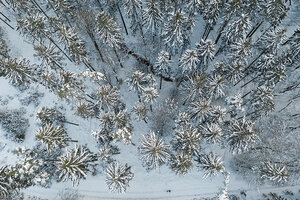In Maine’s winter woods, I’m never alone
While I’m the only human on a snowy trail at times, I’m companioned by the tracks and signs of wild creatures.

A trail winds through an evergreen forest in this small village in northwestern Germany last month.
Hasan Bratic/Picture-Alliance/DPA/AP
The words “winter” and “Maine” seem like a self-evident coupling even to those who don’t live here. When I first announced my intention to move to Maine almost 40 years ago, my grandmother exclaimed, “Maine? You’ll freeze to death!”
It really isn’t so bad. In fact, one of the tricks to living happily in Maine is to learn to embrace the winter, which, in turn, will reciprocate in welcoming ways.
A preeminent grace of Maine is the broad accessibility of nature. My own town is laced with trail upon trail, coursing through pine forests, over streams, and around so-called erratics – boulders deposited during the retreat of the last glacier some 15,000 years ago. Robert Frost nailed the scene when he wrote, “The woods are lovely, dark and deep. ...”
To this end, I have made it a daily ritual to set off into the woods, where the most striking tranquility reigns: One moment I’m walking down a trafficked roadway, and the next – silence.
This time of year, the woods are transparent. The hardwoods have lost their leaves, and the understory has died back. The needle trees – pines, firs, and hemlocks – persist, but they are not enough to keep swords of sunlight from slicing in here and there, illuminating my way.
And so I step along through the snow. I am usually the only one on the trail, but as long as I keep my eyes open, I see evidence everywhere that I am not alone.
The path I tread has been beaten down by other human visitors, but to my left and right the snow is soft, deeper. Animal tracks are abundant there, and I have learned to identify them: rabbit, squirrel, chipmunk, deer, and fox. On rare occasions, I might see the bold, cleft imprint of Maine’s signature animal, the moose. Sometimes I even spot the animals themselves, but fleetingly – against the white snow, a brown or gray pelt is nothing less than an advertisement to some predator.
Lifting my eyes from the forest floor, I see more evidence of animal industry: the occasional dead tree trunk riddled with holes. I’ve learned to read these as well. The long, oval hollows are products of the pileated woodpecker; the rounder ones are drilled out by the hairy woodpecker. Even the small, tame, demure chickadee, Maine’s state bird, is capable of boring a hole in a rotting log to make its home.
All of this reminds me that the woods were not created exclusively for me. I am part of a community. I look to the canopy of the tree cover and there, perched on the highest limb, is a sharp-shinned hawk, as aware of me as I am of it.
I cross over a stream on a simple bridge constructed by the trail-keepers. Below me, beavers have built a dam. I sometimes feel that, if I were to pause and sit down on a rock, all of these forest denizens would arise and gather around me, as if to ask, “So what do you think?”
What I think now is what I thought at the outset of my walk: “The woods are lovely, dark and deep. ...” If it were mine to complete the verse on my own terms, I would add, “and I have company to keep.”
The forecast tonight is for more snow, but abiding temperatures. I’m already eager to get back into the woods, to see what my companions are up to.

